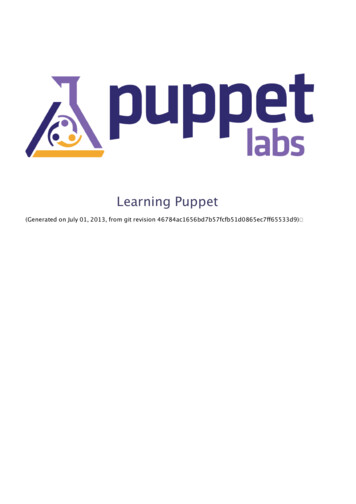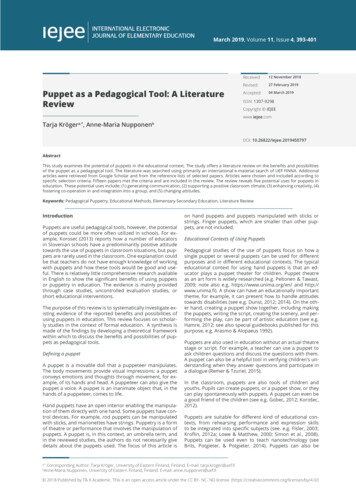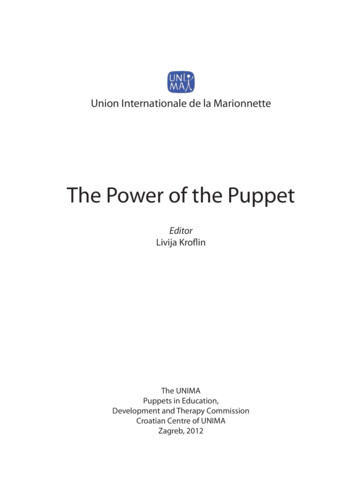
Transcription
PuppetAbout the TutorialPuppet is a configuration management technology to manage the infrastructure onphysical or virtual machines. It is an open-source software configuration management tooldeveloped using Ruby which helps in managing complex infrastructure on the fly.This tutorial will help in understanding the building blocks of Puppet and how it works inan infrastructure environment. All the examples and code snippets used in this tutorial aretested. The working code snippets can be simply used in any Puppet setup by changingthe current defined names and variables.AudienceThis tutorial has been prepared for those who want to understand the features andfunctionality of Puppet and how it can help in reducing the complexity of managing aninfrastructure.After completing this tutorial one would gain moderate level understanding of Puppet andits workflow. It will also give you a fair idea on how to configure Puppet in a preconfiguredinfrastructure and use it for automation.PrerequisitesWe assume anyone who wants to understand and learn Puppet should have anunderstanding of the system administration, infrastructure, and network protocolcommunication. To automate the infrastructure provisioning, one should have a commandover basic Ruby script writing and the underlying system where one wants to use Puppet.Copyright & Disclaimer Copyright 2018 by Tutorials Point (I) Pvt. Ltd.All the content and graphics published in this e-book are the property of Tutorials Point (I)Pvt. Ltd. The user of this e-book is prohibited to reuse, retain, copy, distribute or republishany contents or a part of contents of this e-book in any manner without written consentof the publisher.We strive to update the contents of our website and tutorials as timely and as precisely aspossible, however, the contents may contain inaccuracies or errors. Tutorials Point (I) Pvt.Ltd. provides no guarantee regarding the accuracy, timeliness or completeness of ourwebsite or its contents including this tutorial. If you discover any errors on our website orin this tutorial, please notify us at contact@tutorialspoint.comi
PuppetTable of ContentsAbout the Tutorial . iAudience . iPrerequisites . iCopyright & Disclaimer . iTable of Contents . iiBASIC PUPPET . 11.Puppet Overview . 2Features of Puppet System. 2Puppet Workflow. 3Puppet Key Components . 42.Puppet Architecture . 63.Puppet Installation . 8Prerequisites . 8Facter Installation . 84.Puppet Configuration . 10Open Firewall Ports on Machines . 10Configuration File . 10Key Components of Config File. 125.Puppet Environment Conf . 14Allowed Settings . 156.Puppet Master . 17Prerequisites . 17Creating Puppet Master Server . 17Installing NTP . 17Setup Puppet Server Software . 19Configure Memory Allocation on the Puppet Server . 197.Puppet – Agent Setup . 218.Puppet SSL Sign Certificate Setup . 229.Puppet – Installing & Configuring r10K . 2410. Puppet – Validating Puppet Setup . 26Setting Up the Virtual Machine . 26Validating Multiple Machine Configuration . 2811. Puppet – Coding Style . 30Fundamental Units . 30Metaparameters. 31ii
PuppetResource Collections . 32Run Stages . 35Advanced Supported Features . 38Capitalization . 38Arrays . 39Variables . 39Conditionals . 41If-Else Statement . 42Virtual Resource . 43Comments . 43Operator Precedence . 44Working with Templates . 46Defining and Triggering Services . 4612. Puppet – Manifest Files. 47Manifest File Workflow . 47Writing Manifests . 4813. Puppet Module . 50Module Configuration . 50Modules Source . 50Module Naming . 51Module Internal Organization . 51Module Lookup. 5314. Puppet – File Server . 54File Format . 54Security . 5515. Puppet – Facter & Facts . 57Puppet Facts . 58Custom Facts . 62Using FACTERLIB . 64External Facts . 65ADVANCED PUPPET . 6716. Puppet – Resource . 68Resource Type . 68Resource Title . 70Attributes & Values . 7117. Puppet – Resource Abstraction Layer. 7718. Puppet Template. 85Evaluating Templates . 85Using Templates . 85iii
Puppet19. Puppet Classes . 90Parameterized Class . 9220. Puppet Function . 94File Function . 94Include Function . 94Defined Function . 9521. Puppet – Custom Functions . 96Writing Custom Functions . 96Location to Put Custom Function . 96Creating a New Function . 9722. Puppet Environment . 98Using the Environment on Puppet Master . 98Setting the Clients Environment . 99Puppet Search Path . 10023. Puppet – Type & Provider . 10124. Puppet – RESTful API. 105REST API Security . 105Puppet Master API Reference . 106Puppet Agent API Reference . 10725. Puppet – Live Project . 108Creating a New Module . 108Installing a HTTP Server . 108Running the httpd Server . 110Configuring httpd Server . 111Configuring the Firewall . 113Configuring the SELinux . 115Copying HTML Files in the Web Host . 116iv
PuppetBasic Puppet1
1. Puppet OverviewPuppetPuppet is a configuration management tool developed by Puppet Labs in order to automateinfrastructure management and configuration. Puppet is a very powerful tool which helpsin the concept of Infrastructure as code. This tool is written in Ruby DSL language thathelps in converting a complete infrastructure in code format, which can be easily managedand configured.Puppet follows client-server model, where one machine in any cluster acts as client knownas puppet master and the other acts as server known as slave on nodes. Puppet has thecapability to manage any system from scratch, starting from initial configuration till endof-life of any particular machine.Features of Puppet SystemFollowing are the most important features of Puppet.IdempotencyPuppet supports Idempotency which makes it unique. Similar to Chef, in Puppet, one cansafely run the same set of configuration multiple times on the same machine. In this flow,Puppet checks for the current status of the target machine and will only make changeswhen there is any specific change in the configuration.Idempotency helps in managing any particular machine throughout its lifecycle startingfrom the creation of machine, configurational changes in the machine, till the end-of-life.Puppet Idempotency feature is very helpful in keeping the machine updated for yearsrather than rebuilding the same machine multiple times, when there is any configurationalchange.Cross-platformIn Puppet, with the help of Resource Abstraction Layer (RAL) which uses Puppet resources,one can target the specified configuration of system without worrying about theimplementation details and how the configuration command will work inside the system,which are defined in the underlying configuration file.2
PuppetPuppet WorkflowPuppet uses the following workflow to apply configuration on the system. In Puppet, the first thing what the Puppet master does is to collect the details ofthe target machine. Using the factor which is present on all Puppet nodes (similarto Ohai in Chef) it gets all the machine level configuration details. These details arecollected and sent back to the Puppet master. Then the puppet master compares the retrieved configuration with definedconfiguration details, and with the defined configuration it creates a catalog andsends it to the targeted Puppet agents. The Puppet agent then applies those configurations to get the system into a desiredstate. Finally, once one has the target node in a desired state, it sends a report back tothe Puppet master, which helps the Puppet master in understanding where thecurrent state of the system is, as defined in the catalog.3
PuppetPuppet Key ComponentsFollowing are the key components of Puppet.Puppet ResourcesPuppet resources are the key components for modeling any particular machine. Theseresources have their own implementation model. Puppet uses the same model to get anyparticular resource in the desired state.ProvidersProviders are basically fulfillers of any particular resource used in Puppet. For example,the package type ‘apt-get’ and ‘yum’ both are valid for package management. Sometimes,more than one provider would be available on a particular platform. Though each platformalways have a default provider.ManifestManifest is a collection of resources which are coupled inside the function or classes toconfigure any target system. They contain a set of Ruby code in order to configure asystem.4
PuppetModulesModule is the key building block of Puppet, which can be defined as a collection ofresources, files, templates, etc. They can be easily distributed among different kinds ofOS being defined that they are of the same flavor. As they can be easily distributed, onemodule can be used multiple times with the same configuration.TemplatesTemplates use Ruby expressions to define the customized content and variable input. Theyare used to develop custom content. Templates are defined in manifests and are copiedto a location on the system. For example, if one wants to define httpd with a customizableport, then it can be done using the following expression.Listen % @httpd port % The httpd port variable in this case is defined in the manifest that references this template.Static FilesStatic files can be defined as a general file which are sometimes required to performspecific tasks. They can be simply copied from one location to another using Puppet. Allstatic files are located inside the files directory of any module. Any manipulation of the filein a manifest is done using the file resource.5
2. Puppet ArchitecturePuppetFollowing is the diagrammatic representation of Puppet architecture.Puppet MasterPuppet Master is the key mechanism which handles all the configuration related stuff. Itapplies the configuration to nodes using the Puppet agent.Puppet AgentPuppet Agents are the actual working machines which are managed by the Puppet master.They have the Puppet agent daemon service running inside them.Config RepositoryThis is the repo where all nodes and server-related configurations are saved and pulledwhen required.6
PuppetFactsFacts are the details related to the node or the master machine, which are basically usedfor analyzing the current status of any node. On the basis of facts, changes are done onany target machine. There are pre-defined and custom facts in Puppet.CatalogAll the manifest files or configuration which are written in Puppet are first converted to acompiled format called catalog and later those catalogs are applied on the target machine.7
3. Puppet InstallationPuppetPuppet works on the client server architecture, wherein we call the server as the Puppetmaster and the client as the Puppet node. This setup is achieved by installing Puppet onboth the client and well as on all the server machines.For most of the platforms, Puppet can be installed via the package manager of choice.However, for few platforms it can be done by installing the tarball or RubyGems.PrerequisitesFactor is the only pre-requisite that does not come along with the standard package editionof Puppet. This is similar to Ohai which is present in Chef.Standard OS LibraryWe need to have standard set of library of any underlying OS. Remaining all the systemcomes along with Ruby 1.8.2 versions. Following is the list of library items, which an OSshould consist of. base64 cgi digest/md5 etc fileutils ipaddr openssl strscan syslog uri webrick webrick/https xmlrpcFacter InstallationAs discussed, the facter does not come along with the standard edition of Ruby. So, inorder to get the facter in the target system one needs to install it manually from the sourceas the facter library is a pre-requisite of Puppet.This package is available for multiple platforms however just to be on the safer side it canbe installed using tarball, which helps in getting the latest version.8
PuppetFirst, download the tarball from the official site of Puppet using the wget utility. wget st.tgz------: 1Next, un-tar the tar file. Get inside the untarred directory using the CD command. Finally,install the facter using install.rb file present inside the facter directory. gzip -d -c facter-latest.tgz tar xf - -----: 2 cd facter-* ------: 3 sudo ruby install.rb # or become root and run install.rb -----:4Installing Puppet from the SourceFirst, install the Puppet tarball from the Puppet site using wget. Then, extract the tarballto a target location. Move inside the created directory using the CD command. Usinginstall.rb file, install Puppet on the underlying server.# get the latest tarball wget st.tgz -----: 1# untar and install it gzip -d -c puppet-latest.tgz tar xf - ----: 2 cd puppet-* ------: 3 sudo ruby install.rb # or become root and run install.rb -------: 4Installing Puppet and Facter Using Ruby Gem# Installing Facter wget gem sudo gem install facter-1.5.7.gem# Installing Puppet wget .gem sudo gem install puppet-0.25.1.gem9
4. Puppet ConfigurationPuppetOnce we have Puppet installed on the system, the next step is to configure it to performcertain initial operations.Open Firewall Ports on MachinesTo make the Puppet server manage the client’s server centrally, one needs to open aspecified port on all the machines, i.e. 8140 can be used if it is not in use in any of themachines which we are trying to configure. We need to enable both TCP and UDPcommunication on all the machines.Configuration FileThe main configuration file for Puppet is etc/puppet/puppet.conf. All the configurationfiles get created in a package-based configuration of Puppet. Most of the configurationwhich is required to configure Puppet is kept in these files and once the Puppet run takesplace, it picks up those configurations automatically. However, for some specific tasks suchas configuring a web server or an external Certificate Authority (CA), Puppet has separateconfiguration for files and settings.Server configuration files are located in conf.d directory which is also known as the c/puppetlabs/puppetserver/conf.d path. These config files are in HOCON format,which keeps the basic structure of JSON but it is more readable. When the Puppet startuptakes place it picks up all .cong files from conf.d directory and uses them for making anyconfigurational changes. Any changes in these files only takes place when the server isrestarted.List File and Settings File global.conf webserver.conf web-routes.conf puppetserver.conf auth.conf master.conf (deprecated) ca.conf (deprecated)There are different configuration files in Puppet which are specific to each component inPuppet.10
PuppetPuppet.confPuppet.conf file is Puppet’s main configuration file. Puppet uses the same configuration fileto configure all the required Puppet command and services. All Puppet related settingssuch as the definition of Puppet master, Puppet agent, Puppet apply and certificates aredefined in this file. Puppet can refer them as per requirement.The config file resembles a standard ini file wherein the settings can go into the specificapplication section of the main section.Main Config Section[main]certname Test1.vipin.comserver TestingSrvenvironment productionruninterval 1hPuppet Master Config File[main]certname puppetmaster.vipin.comserver MasterSrvenvironment productionruninterval 1hstrict variables true[master]dns alt names .comreports puppetdbstoreconfigs backend puppetdbstoreconfigs trueenvironment timeout unlimitedDetail OverviewIn Puppet configuration, the file which is going to be used has multiple configurationsections wherein each section has different kinds of multiple number of settings.11
PuppetConfig SectionPuppet configuration file mainly consists of the following config sections. Main: This is known as the global section which is used by all the commands andservices in Puppet. One defines the default values in the main section which canbe overridden by any section present in puppet.conf file. Master: This section is referred by Puppet master service and Puppet certcommand. Agent: This section is referred by Puppet agent service. User: It is mostly used by Puppet apply command as well as many of the lesscommon commands.[main]certname PuppetTestmaster1.example.comKey Components of Config FileFollowing are the key components of Config file.Comment LinesIn Puppet, any comment line starts with (#) sign. This may intend with any amount ofspace. We can have a partial comment as well within the same line.# This is a comment.Testing true #this is also a comment in same lineSettings LinesSettings line must consist of Any amount of leading space (optional) Name of the settings An equals to sign, which may be surrounded by any number of space A value for the settingSetting VariablesIn most of the cases, the value of settings
Puppet Agents are the actual working machines which are managed by the Puppet master. They have the Puppet agent daemon service running inside them. Config Repository This is the repo where all nodes and server-related configurations are saved and pulled when required. 2.File Size: 1MB










